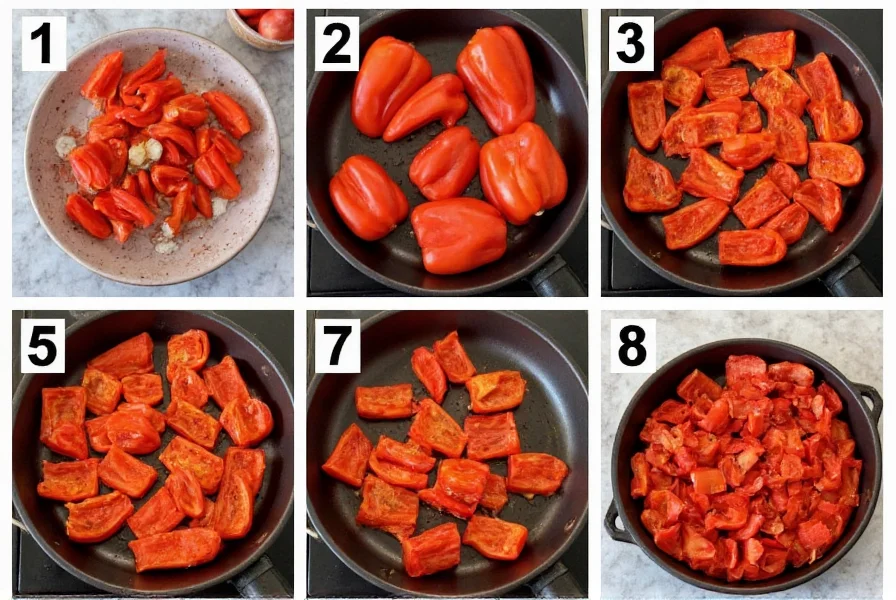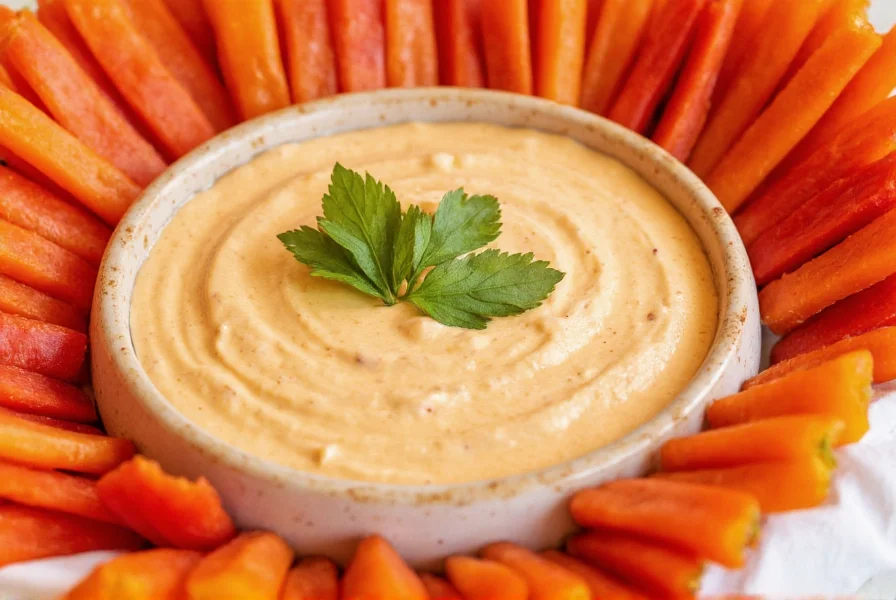Creating the perfect red pepper dip begins with understanding the essential components that transform simple ingredients into a standout appetizer. While many store-bought versions exist, homemade red pepper dip provides superior flavor control and freshness. The foundation of any exceptional red pepper dip recipe starts with quality roasted red peppers, which deliver that distinctive sweet, smoky flavor impossible to replicate with raw peppers.
The Science Behind Flavorful Red Pepper Dip
Roasting red bell peppers isn't just a cooking step—it's a flavor transformation process. When peppers roast, their natural sugars caramelize, creating complex flavor compounds that raw peppers lack. The Maillard reaction during roasting develops those rich, smoky notes that define authentic red pepper dip. For optimal results, use large, firm red bell peppers with thick walls, as they contain more sugar for caramelization and less water content, preventing a watery dip.

Essential Ingredients for Perfect Texture and Flavor Balance
The magic of red pepper dip lies in the balance between sweet, acidic, and savory elements. While recipes vary, these components form the foundation of a well-constructed dip:
| Ingredient Category | Function | Common Options |
|---|---|---|
| Base | Provides primary flavor and texture | Roasted red bell peppers (not jarred), roasted poblano peppers for smokiness |
| Acid | Brightens flavors and balances sweetness | Fresh lemon juice, red wine vinegar, sherry vinegar |
| Fat | Creates creamy texture and carries flavors | Olive oil, tahini, Greek yogurt (for lighter version) |
| Aromatics | Adds depth and complexity | Fresh garlic, roasted garlic, shallots |
| Seasonings | Enhances overall flavor profile | Smoked paprika, cumin, fresh herbs, sea salt |
Step-by-Step Preparation for Restaurant-Quality Results
Follow these professional techniques to elevate your homemade red pepper dip:
Pepper Roasting Method
For the most authentic roasted red pepper dip from scratch, skip jarred peppers. Place whole red bell peppers directly over a gas flame or under a broiler, turning frequently until completely blackened on all sides. Transfer to a covered bowl for 10 minutes, then peel under running water, removing all blackened skin while preserving the pepper flesh. This technique maximizes flavor development while minimizing water content.
Texture Perfection Technique
After blending your ingredients, strain the mixture through a fine-mesh sieve, pressing with a spatula to extract maximum flavor while removing any fibrous bits. This professional step ensures a silky-smooth texture that distinguishes exceptional red pepper dip from ordinary versions. For best results when making roasted red pepper dip without cream cheese, use Greek yogurt or tahini as your fat component and chill for at least two hours before serving.

Variations to Expand Your Culinary Repertoire
While traditional Spanish romesco and Italian peperonata inspire many red pepper dip recipes, several adaptations cater to different dietary needs and flavor preferences:
- Mediterranean Style: Add toasted almonds and sherry vinegar for an authentic romesco variation
- Spicy Harissa Version: Incorporate 1-2 teaspoons of harissa paste for North African flair
- Vegan Option: Substitute tahini for dairy components in healthy red pepper dip recipe without cream cheese
- Lighter Alternative: Use Greek yogurt instead of olive oil for reduced calories while maintaining creaminess
- Smoky Chipotle Twist: Replace 1 roasted red pepper with a chipotle pepper in adobo sauce
Perfect Pairings: Maximizing Your Red Pepper Dip Experience
The best bread for red pepper dip pairing provides contrast in texture while complementing the dip's flavor profile. Consider these serving suggestions:
- Crudités: Bell pepper strips, cucumber rounds, endive leaves, and radish slices maintain the vegetable-forward theme
- Bread Options: Sourdough baguette slices, pita chips, or grilled ciabatta offer ideal texture contrast
- Protein Pairings: Serve alongside grilled chicken or fish for a complete meal
- Breakfast Application: Spread on avocado toast or as an omelet filling
- Meal Integration: Use as a sandwich spread or pasta sauce base
Storage and Shelf Life: Maintaining Peak Quality
Proper storage is crucial for maintaining the vibrant color and fresh flavor of homemade red pepper dip. Follow these storage tips for homemade red pepper dip to maximize freshness:
- Store in an airtight container with plastic wrap pressed directly against the dip's surface to prevent oxidation
- Refrigerate for up to 5 days—any longer and flavor degradation becomes noticeable
- Freeze in ice cube trays, then transfer to freezer bags for up to 3 months (thaw in refrigerator)
- Always use clean utensils when serving to prevent bacterial contamination
- If separation occurs, simply stir gently before serving—this is normal with olive oil-based dips
Troubleshooting Common Red Pepper Dip Issues
Even experienced cooks encounter challenges when preparing red pepper dip. Here's how to address frequent problems:
Watery Dip Solution
If your dip has excess liquid, you've likely used jarred peppers or didn't properly drain roasted peppers. To fix troubleshooting watery red pepper dip, strain through cheesecloth for 30 minutes or add 1 teaspoon of cornstarch slurry (mixed with cold water) while gently heating.
Flavor Balancing Techniques
When the dip tastes flat, add acid incrementally—a quarter teaspoon of lemon juice at a time. If too acidic, balance with a pinch of sugar or additional roasted peppers. For lack of depth, incorporate a small amount of smoked paprika or roasted garlic.
Nutritional Profile and Health Benefits
Red pepper dip offers more than just great taste—it delivers significant nutritional benefits. Bell peppers are exceptionally high in vitamin C (one medium pepper provides 169% of daily value) and contain substantial vitamin A, potassium, and antioxidants. When prepared without heavy cream or excessive oil, red pepper dip becomes a nutrient-dense option compared to many traditional dips.
The capsaicin in peppers, even mild bell peppers, may support metabolism and provide anti-inflammatory benefits. Using olive oil as your fat source adds heart-healthy monounsaturated fats, while substitutions like Greek yogurt increase protein content. This makes a well-constructed red pepper dip a smart choice for those seeking both flavor and nutritional value in their appetizers.
Frequently Asked Questions
Can I make red pepper dip without a food processor?
Yes, you can prepare red pepper dip without specialized equipment. Finely chop roasted peppers and other ingredients, then mash thoroughly with a fork or potato masher. For smoother texture, use a mortar and pestle to grind ingredients into a paste. While the texture won't be as uniform as processor-made dip, the flavor will remain excellent. This method works particularly well for small batches of red pepper dip from scratch.
What's the difference between roasted red pepper dip and bell pepper dip?
Roasted red pepper dip specifically uses peppers that have been roasted, which develops complex caramelized flavors and reduces water content. Bell pepper dip may use raw peppers, resulting in a brighter, more vegetal flavor and potentially watery texture. Authentic roasted red pepper dip vs bell pepper dip shows significant flavor depth differences—the roasting process transforms simple bell peppers into sweet, smoky ingredients essential for traditional recipes. For best results, always roast your peppers rather than using them raw.
How can I make my red pepper dip more flavorful?
Enhance your red pepper dip's flavor profile by incorporating these professional techniques: roast your own peppers instead of using jarred, add a small amount of toasted nuts (like almonds or walnuts) for depth, use fresh garlic rather than powdered, incorporate high-quality extra virgin olive oil, and allow the dip to rest for 24 hours before serving. For smokiness without heat, add a pinch of smoked paprika. The key to exceptional flavor in any red pepper dip recipe is balancing sweet (peppers), acidic (lemon/vinegar), and savory (garlic, salt) elements.
Is red pepper dip typically gluten-free?
Yes, traditional red pepper dip is naturally gluten-free as its primary ingredients (roasted peppers, garlic, olive oil, lemon juice) contain no gluten. However, always verify that any additional ingredients or store-bought versions don't contain gluten-containing additives. When serving, pair with gluten-free options like vegetable sticks, gluten-free crackers, or rice cakes to maintain the gluten-free status. This makes red pepper dip an excellent choice for those following gluten-free diets, especially when prepared as a healthy red pepper dip recipe without cream cheese or other non-essential additives.











 浙公网安备
33010002000092号
浙公网安备
33010002000092号 浙B2-20120091-4
浙B2-20120091-4